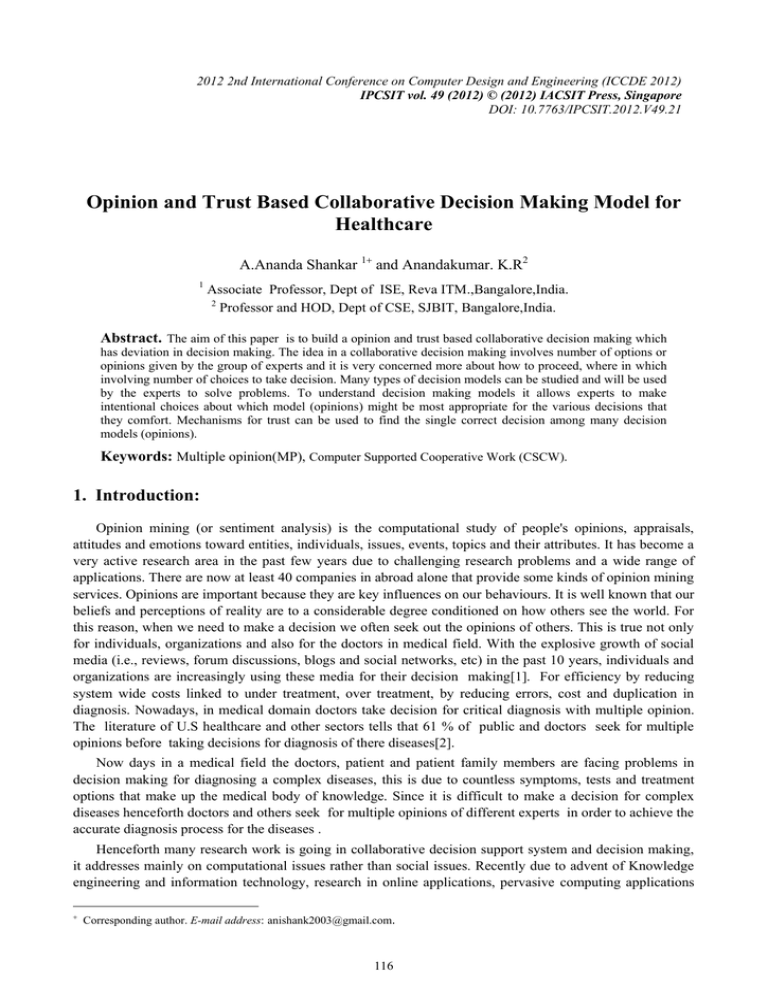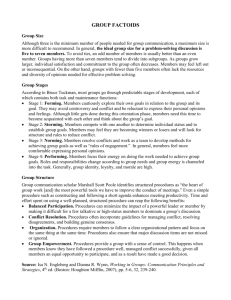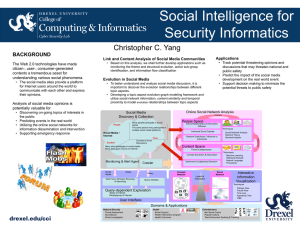Document 13136687
advertisement

2012 2nd International Conference on Computer Design and Engineering (ICCDE 2012) IPCSIT vol. 49 (2012) © (2012) IACSIT Press, Singapore DOI: 10.7763/IPCSIT.2012.V49.21 Opinion and Trust Based Collaborative Decision Making Model for Healthcare A.Ananda Shankar 1 and Anandakumar. K.R2 1 Associate Professor, Dept of ISE, Reva ITM.,Bangalore,India. 2 Professor and HOD, Dept of CSE, SJBIT, Bangalore,India. Abstract. The aim of this paper is to build a opinion and trust based collaborative decision making which has deviation in decision making. The idea in a collaborative decision making involves number of options or opinions given by the group of experts and it is very concerned more about how to proceed, where in which involving number of choices to take decision. Many types of decision models can be studied and will be used by the experts to solve problems. To understand decision making models it allows experts to make intentional choices about which model (opinions) might be most appropriate for the various decisions that they comfort. Mechanisms for trust can be used to find the single correct decision among many decision models (opinions). Keywords: Multiple opinion(MP), Computer Supported Cooperative Work (CSCW). 1. Introduction: Opinion mining (or sentiment analysis) is the computational study of people's opinions, appraisals, attitudes and emotions toward entities, individuals, issues, events, topics and their attributes. It has become a very active research area in the past few years due to challenging research problems and a wide range of applications. There are now at least 40 companies in abroad alone that provide some kinds of opinion mining services. Opinions are important because they are key influences on our behaviours. It is well known that our beliefs and perceptions of reality are to a considerable degree conditioned on how others see the world. For this reason, when we need to make a decision we often seek out the opinions of others. This is true not only for individuals, organizations and also for the doctors in medical field. With the explosive growth of social media (i.e., reviews, forum discussions, blogs and social networks, etc) in the past 10 years, individuals and organizations are increasingly using these media for their decision making[1]. For efficiency by reducing system wide costs linked to under treatment, over treatment, by reducing errors, cost and duplication in diagnosis. Nowadays, in medical domain doctors take decision for critical diagnosis with multiple opinion. The literature of U.S healthcare and other sectors tells that 61 % of public and doctors seek for multiple opinions before taking decisions for diagnosis of there diseases[2]. Now days in a medical field the doctors, patient and patient family members are facing problems in decision making for diagnosing a complex diseases, this is due to countless symptoms, tests and treatment options that make up the medical body of knowledge. Since it is difficult to make a decision for complex diseases henceforth doctors and others seek for multiple opinions of different experts in order to achieve the accurate diagnosis process for the diseases . Henceforth many research work is going in collaborative decision support system and decision making, it addresses mainly on computational issues rather than social issues. Recently due to advent of Knowledge engineering and information technology, research in online applications, pervasive computing applications Corresponding author. E-mail address: anishank2003@gmail.com. 116 and medical application which is becoming more popular. The current scenario needs social issues such as trust, belief, reputation and are gaining importance. Highly complex problems are usually solved by a team of experts and decision making that involves uncertain data is challenging for human decision makers. Today collaborative decision making is an important human activity and it has many practical applications in medical, society ,economy, management and engineering, etc. Researchers are faced with new challenges in theory and methods of Computer Supported Cooperative Work (CSCW) with the rapid advent of internet and information technology. Also, the existing groupware do not have efficient tools to effectively analyse, predict and provide support for social facets collective decision in medical diagnosis.[3]. One of the challenges in collaborative decision making is social decision making in a computer mediated environment and also it is further complicated in medical field. Now days in medical domain, it is difficult to make a decision for complex diseases henceforth doctors seek multiple opinions of different experts in order to achieve the accurate diagnosis process for the diseases [4]. In such environment CSCW gives a good assistance. Under collaborative environment Experts can make highly accurate decisions, as they have background knowledge about the problem with their past experience. Since experience is very subjective, different experts propose different diagnosis and decision on the same facts gathered with different or same observation of a patient. Also different experience can lead to a different diagnosis on same specific case. A couple of decades ago, people deemed doctors as the ultimate authority. But now days doctors and patients seek multiple opinions[4]. The objective of successful diagnosis is by experts past experience or the knowledge gained from those experience. Experts can make prediction from previous observations(solved cases) and produce diagnosis for new cases. Using these experience experts can suggest good opinions about the diseases. Similarly different experts having different background knowledge(experience) can suggest different opinions ,which leads for multiple opinions[5]. 2. Existing Methods: For completeness the researchers contributed several methods to combine the individual opinions. Which are as follows: 2.1. Models of Dynamics Opinion: Fan Jia, Yun Liu & Fei Ding[6] proposed a model called Pheromone Dynamics Model. Pheromone is a communication chemical that possesses certain meanings that are mutually understood by individuals of same species. The individuals would sense and deposit some pheromone can be sensed by other individuals. Then phenomena of bifurcation and consensus can be observed under different values of evaporation. With increase in the value of evaporation than bifurcation appears in evolution of opinions. In this way the model is able to generate opinion on any issues. Shusong LI , Shiyong ZHANG[7] proposed a model called Bounded Confidence Dynamics Model. In this model the agent moves in an uncertain direction in two dimensionally space based on „Eye Shot‟ concept, which limits the set of neighbours around the agent. They have considered different agents in the group based on their eyeshot i.e. firstly the agent called infector agent with large eyeshot and will shorter the consensus time ,Secondly the agent called extremist agent with high confidence, who can induce final opinion of the system and Thirdly the agent called leader agent who posses high confidence and large eye spot. This bounded difference is stimulated by using different graph to show how different agents in a group can be classified. Ananhita Mirtabatabaei & Francesco Bullo[8] proposed a model called Opinion Dynamics in Heterogeneous Network model. In this model each agent in a group maintains a real number describing its opinion and each agent updates its opinion by averaging all other opinions that are within some given confidence range. This model classifies the agents via their interconnection topology and accordingly computes the equilibrium of the system. It conjecture that any trajectory of this model eventually converges to a steady state under fixed topology. To establish this conjecture, it derives two novel sufficient conditions: 117 both conditions guarantee convergence and constant topology for infinite time, while one condition also guarantees monotonic of the convergence. In the evolution under fixed topology for infinite time, it defines leader groups that determine the followers‟ rate and direction of convergence. 2.2. Based on Trust Negotiation: P.A.Bonatti, J.L.De Olmedila and L.Sauro [9] proposed a model called Rule based Trust negotiation. Here they have used PROTUNE architecture in order to implement a rule based trust negotiation system. And they compare with Protune model with many other models like Carsadra, EPAL, KAOS, PeerTRUST, TPL etc. in order to focus both on criteria having a practical relevance based on action, support, extensibility and mechanisms etc. Ting Yu,Marianne Winslectt [10] proposed a model called interoperable strategies using trust. Here they focus on guaranteeing interoperability between different strategies . First they have proposed a very simple trust negotiation protocol for trust builder negotiation architecture. Then they have introduced the concept of strategy families and closed set of strategies. And it was applied on disclosure tree in order to indentify the natural mapping between full disclosure tree and safe credential disclosure sequence. Khalari gaurangkumar, Chandhari minubhai[11] proposed trust model for cloud computing. In this model they are trying to achieve trust in the cloud through preventive, detective and corrective control measures for data storage and maintenance. And they are emphasizing on two types of logging in to over come problems and user activities in one log file. Zhengxing Huang, Xudong Lu, Huilong Duan, Chenhui Zhao[12], proposed trust model for medical knowledge recommendation , in this model they proposed a approach which generates clinician trust profile based on the measure of trust factors implicitly from clinicians past rating behaviors on knowledge items and then it generates clinician trust profile to incorporate into collaborative filtering techniques to improve the quality of medical knowledge recommendation, to solve the information-overload problem by suggesting knowledge items of interest to clinicians. 2.3. Based on Collaborative Models. Ioan Alfred Letia and Radu Razvan Slavescu[13] proposed trust model for collaborative agents. In this model they present Belief Recipe Trees(BRT) as an improved solution for the problem of deciding how to engage in a collaborative activity for helping a partner. First, it extends the Probabilistic Recipe Tree structure to a BRT by employing trust values in form of subjective opinions in order to find decision tree operations accordingly. Zhibin Wu,JiupingXu[14] proposed a model called consistency consensus based decision support model for Group decision and it is based on reciprocal preference relations. Which Inspires the concept of a deviation measure between two matrices, an individual consistency index and a group consensus index are presented. To achieve a predefined consensus level, an interactive consensus reaching process is provided where the group reciprocal preference relation is seen as a reference when experts change their preferences. Hyesung Seok, Shimon Y. Nof, Florin G. Filip[15], proposed a model called Sustainability decision support system based on collaborative control theory, in this model they review the concepts of sustainability and its practical issues and specifically focusing on the issues of supply networks. Sustainability issues are usually complex because beyond their inherent challenges, there are conflicts among stakeholders within organizations and between organizations, in order to take more effective solutions. They have consider Decision Support Systems (DSSs) to help optimize solutions related with sustainability issues, and review their concepts and usefulness based on previous work and they have suggest strategies applying the Collaborative Control Theory (CCT) principles to augment DSS in order to over come the weakness in the decisions. The survey shows that less work is carried out by considering social issues like trust and conflict resolution. In most of the medical application trust plays vital role. 3. Proposed Methodology: 118 In a complicated problems/critical conditions seeking multiple opinions is common by the experts. Here, we are proposing a model for collaborative decision making where experts/doctors on particular task/case have multiple opinions. The experts seek for multiple opinions from different experts, where each expert has his own opinion and estimated value for their different experiences and knowledge. The model uses a social factor trust to avoid conflicts, disparity and uncertainty in multiple opinions. This trust based model predicts the correct and come out with single opinion for tasks/cases with well focused collaborative decision making. The model has major steps: Step 1: Proposing a Collaborative agent architecture . Step 2: Gathering/History of opinion of experts for each tasks/cases. Step 3: Trust and Reputation computation process. Step 4: Prediction process. 4. Conclusions: In this paper, we propose a Computer Supported Cooperative Work (CSCW), a novel model to deal with Opinion and Trust based Collaborative Decision Making Model for Healthcare 5. References: [1] Yuefeng li, Ning Zhong, Raymond Y.K.lau “ Topic Feature Discovery and Opinion Mining”10thIEEEinternational Conference on Data Mining(ICDM‟10. Sydney,Australia [2] James Manyika,Michael Chui,Brad Brown,Jacques Bughin,Richard Dobbs,Charles Roxburgh Angela Hung Byers from McKinsey Global Institute “ Big data: The next frontier for innovation, competition, and productivity “ McKinsey & Company 2011. [3] Indiramma.M, Ananda Kumar.K.R. “ Collaborative decision making frame work for multiagent system“ Proceeding of the International conference on computer & communication Engg 2008, May 1315,2008,Malaysia. [4] Mitja Lenic, Petra Povalej, Milan Zorman, Peter Kokol,faculty of ectrical engineering and computer science, university of Maribor, slovenia,Proceedings of the 17th IEEE symposium on computer-based medical systems(CBMS‟04) 1063- 7125/04,2004 IEEE. [5] Mitja Lenic, Petra Povalej, Milan Zorman, Peter Kokol,faculty of ectrical engineering and computer science, university of Maribor, slovenia,Proceedings of the 17th IEEE symposium on computer-based medical systems(CBMS‟04) 1063- 7125/04,2004 IEEE. [6] Fan Jia, Yun Liu, Fei Ding & Di Xie,“ A Pheromone Model For Public Opinion Formation “ ,978-1-4211- 555867/10/2010 IEEE [7] Shusong LI , Shiyong ZHANG, “Leader and Follower: Agents in an Opinion Dynamics and Bounded Confidence Model on the Stochastic Movement World”, 2010 2nd International Conference on ComputationalIntelligence and Natural Computing (CINC) [8] AnanhitaMirtabatabaei,FrancescoBullo,“On Opinion Dynamics in Heterogeneous Networks”American Control Conference onComputer networks,CA,USA june 29-2011. [9] P.A.Bonatti, J.L..De Coi, D.Olmedilla, L.saro “ A Rule based trust Negotiation system “ NOEREWERSE,IST-04506779 [10] Ting Yu, Marianne Winslett “Interoperable stratergies in Automated trust negotiation “ [11] ACM 1-58113-385/11/USA. [12] Khalari gaurangkumar, Chandhari minubhai “ To Achieve Turst in the Cloud “2012 Second International Conference on Advanced Computing & Communication Technologies, 978-0-7695-4640-7/12. [13] Zhengxing Huang, Xudong Lu, Huilong Duan, Chenhui Zhao “Collaboration-based medical knowledge recommendation “ Artificial Intelligence in Medicine 55(2012) 13-24, contents lists available at SciVerse 119 ScienceDirect Artificial Intelligence in Medicine and journal homepage: www.elseviercom/locate/aiim (0933-3657). [14] Ioan Alfred Letia, Radu Razvan Slavescu “ Collaborative Agent Planning Using a Subjective Logic Based Trust Model “ , 978-1-4244-8230-6/10 2010 IEEE. [15] Zhibin Wu,JiupingXu “ A concise consensus support model for group decision making with reciprocal preference relations based on deviation measures” received in revised form 14 March 2012; accepted 14 March 2012, contents lists available at SciVerse ScienceDirect,0165-0114,201Elsevier,B.V.All right sreserved.0.1016/j.fss.2012.03.016. [16] Hyesung Seok, Shimon Y. Nof, Florin G. Filip “Sustainability decision support system based on collaborative control theory “1367-5788/$ - see front matter_2012 Elsevier Ltd. All rights reserved. http://dx.doi.org/10.1016/j.arcontrol.2012.03.007. 120



